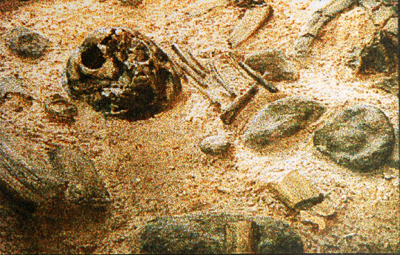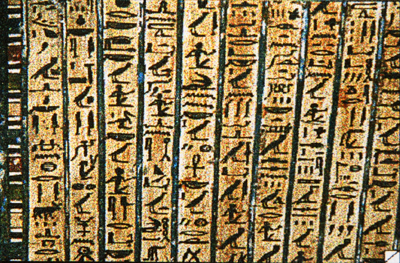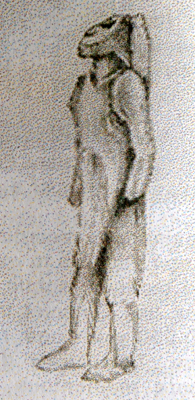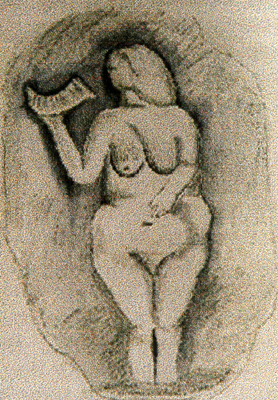MANY PATHS, ONE HORIZON
The story of mankind's spiritual awakening,
and of the part we play in it.
© Kit Constable Maxwell
3. BIRTH OF AWARENESS
~~~~~~~~~~~~~~~~~~~~~~
People weren't created - they evolved. The evolution of early
quadrupeds, like the lemurs, gibbons and monkeys into the species
we now call apes was a slow process of change which challenges our
scientific skills to identify the different evolving stages. At 30m
years ago Pliopithecus was credited with having started the genetic
drift into the mammalian sub species. Ramapithecus, at 14m years ago,
was unmistakably hominid yet still undoubtedly ape. Sometimes he would
walk on two legs in pursuit of his vegetarian diet; more often he
was on four, like gorillas to this day.
Another 12m years of evolutionary change passed before Australopithecus
Africanus emerged, the 'Southern Ape of Africa'. He was still developing
the distinctive hominoid stance of a biped, as can be seen from the
fossilised bones of the period , and beginning to use his hands to
fashion crude stone tools for use in clubbing and striking. His diet
now included meat, a highly concentrated supply of protein, and the
time spent prospecting for food was therefore reduced.
|
Pliopithecus Ramapithecus A/Africanus, Homo Sapiens, Neanderthal, Cro Magnon 30m
14m
(Lucy,3.2m)5 1.5m
0.6m
110k 38k
|
Pliopithecus to Cro Magnon. The great 30 million-year
trek of mankind.
5An Australopithecus Afarensis fossil dubbed 'Lucy' dating from 3.2m
years ago,
is the one link that bridges this long evolutionary gap.
It then took a further 1m years for the next stage to appear, the
now fully omnivorous Homo Erectus, who lived around 1.5m years ago,
and who was not, of course, the first erect member of the species.
His development revealed a continuing humanising of physical appearance
and social structures. This stage then slowly evolved into the slightly
more refined Homo Sapiens, with his larger brain and lighter skull.
Peking Man, 600,000 BC, was the classifying discovery of this
age, and is generally credited with exploiting the domestic potential
of fire.
NEANDERTHAL
Neanderthal Man was the next development of the pre-humans, from
about 110,000 years ago, and his many fossil remains reveal a primitive
but socially ordered genre using fire regularly, an element still
untamed by any other species. The powerful and stocky Neanderthals
inhabited Europe and Asia from the Atlantic to the Hindu Kush. This
widely distributed hunter gatherer was smaller than modern man, but
boasted a bigger brain. Camp fires, cave dwellings and hunting tools
all tell of a developing social structure that was so much a feature
of man's early separation from his ape cousins. Art and culture were
undeveloped, however, and Neanderthals had yet to develop a vocabulary.

Neanderthal child's grave, 70,000 BC, reconstructed
as unearthed.
Natural History Museum.
Neanderthal man was not renowned for his prowess as a hunter - he
does not appear to have been much more than an itinerant scavenger
- nor even for his roving nature; he didn't trade with his neighbours,
and his stone tools seldom came from more than 30 miles from the sites
where they were discovered. What was remarkable about him was that
he, alone among the protohumans, developed the profoundly original
ethic of care for the elderly, and even more profound than this, burial
of the dead. This is one of the very first signs we have of the growing
awareness of early mankind as he separated further and further from
his instinctive animal heritage.
From time immemorial monkeys, apes and hominids had, in common with
every other life form on earth, abandoned their sick and dying and
deserted their dead. A migrant troupe couldn't accommodate the lame,
injured or elderly in their daily struggle for survival. Association
with the dead served no biological or evolutionary function, and therefore
played no part in the daily routine of life.
INTELLECT
Concern for the dead, therefore, was an enormous step forward
in that it revealed for the first time in 30 million years the earliest
signs of a developing intellect. The intellect is the mental faculty
that processes abstract thoughts, like "who made me?". Until this
time life had been governed, very satisfactorily, by instinct alone.
And instincts, passed through inherited genes, served solely the demands
of procreation and survival, nothing else.
Neanderthal's unprecedented step for mankind was short lived, however.
Despite his great brain, his intelligence remained stubbornly timelocked
and he developed little in his 60,000 years. The old stone tools he'd
inherited from Homo Sapiens were still in use at the end. He'd never
thought of binding a flint to a short stake and inventing the world's
first hatchet. And a bow would have been way beyond him. He never
managed to think of making a needle, so his clothes would have been
poor protection from his ice age environment. The evidence suggests
he never built a boat, and in 60,000 years never found a way of crossing
the 8 mile straits of Gibraltar from his chilly Iberian homeland to
the warm and fertile plains of North Africa.
By 40,000 BC Neanderthal's run was almost over. The receding ice
age and the rapid spread of a new hominid species from Africa probably
took the Neanderthals by surprise and placed them firmly on the endangered
species list.
CRO MAGNON MAN
The new species probably sprang from the Africanus stock of 2m
years before, and was not merely a parallel species but a very different
animal springing from a much earlier divergence of the family tree
of mankind. Cro-Magnon, thus named (after the Dordogne site where
he was first found) was a different size, different shape, different
weight. He is described as 'modern man' in the respect that very little
visible change has occurred in the human physique since he appeared
in our evolutionary heritage some 38,000 years ago.
Neanderthal's primitive facial expression, short stature, and hairy,
muscular stance probably did little to encourage cohabitation with
the newcomers; or perhaps, as palaeontologists now believe, the Neanderthal
gestation period was not nine but twelve months duration - which would
have generally ruled against the birth of Neanderthal/Cro Magnon hybrids.
Both species were now omnivorous, but Cro-Magnon's superiority rapidly
revealed itself in his high specification spears fitted with shaped
and barbed flint tips. This would have given him a huge advantage
over the lumbering Neanderthals with their crude hand-held rocks.
Their refined hunting skills and their appetite for meat, even Neanderthal
meat, may well have contributed to Neanderthal's rapid extinction.
The Neanderthal period marked in many ways the end of primitive man,
as the newcomers bore no resemblance to the thickset cousins they
displaced. They walked upright, wore fitted clothes and developed
rapidly changing skills to meet their changing needs; needles for
stitching, fish hooks and nets for fishing, sophisticated and finely
worked stone tools for striking, cutting and slicing.
Cro-Magnon flourished, proliferated and colonised the green and fertile
land mass of Europe and Asia, now burgeoning again after centuries
of permafrost. Great herds of grazing animals became walking game
larders to the many following troupes, just as the Lapps' working
relationship with migrating herds of reindeer continue this resourceful
tradition up to the present day.
This period is described by anthropologists as the Great Leap Forward,
a period of rapid learning and escalating human achievement. Neither
do we know why it took so long for mankind to develop intellect and
intelligence, nor do we know what triggered this sudden burst of mental
activity, with the arrival of original and creative art that has continued
largely unabated to the present day.
COMMUNICATION
The dissemination of information may have been the one Giant Step
that enabled mankind to energise the inexplicable miracle of the mammalian
brain, an organ of apparently boundless potential and a limitless
appetite for development. The prime mental functions of modern mankind
are fourfold:
THE FOUR STEPPING STONES TO KNOWLEDGE |
learn... think... reason...
communicate... |
Any one of these on its own is of limited value, but all four together
trigger a rapid exchange of knowledge throughout the world of mankind.
Within these functions lie the seeds of change from our apish ancestry
to the doorway of human potential.
The greatest single development of the day lay in communication
and the development of speech. Neanderthals didn't vocalise more than
a few sounds, and like their ape contemporaries these would be restricted
to grunted warnings of predators or adversaries, or humming cadences
of pleasure at finding ripe food. Cro Magnons, on the other hand,
now hunting in co-ordinated family groups, needed to discuss, plan
and implement their hunt strategy for the minimum expenditure of effort
with the maximum (edible) reward. This demanded the development of
a vocabulary, and more, the ability to vocalise it. This was a task
which no other animal has come near to matching, although some ape
troupes have recognisably different sounds for different alarms; warnings
of eagles, snakes or leopards all invoke different sounds at which
the troupe will all look up, look down or look out.
CAVE ART
Early cave paintings were probably simple aids to communication
too, which in the fullness of time would lead to the many early forms
of communication, such as:
Pictographs, Chinese, 6,000 BC
Hieroglyphics, Egyptian, from 3,500
BC
Cuneiform, Sumeria, Mesopotamia, 3,500 BC.

Ancient Egyptian inscription on the door
of
a priest's tomb,
2,500 BC
Cave paintings, recording a visible spectrum of beasts and men, soon
adapted to express the artists' creative whims. The stylised outlines,
subtle shading and structured compositions in caves like Chauvet in
the Ardèche, provisionally dated to over 30,000 years ago, reveal
a highly developed expertise for the time. This newly discovered creative
freedom heralded one more momentous step in the rise of mankind where
biologically valueless sentiment revealed itself in unique adaptations
of visible phenomena. Here we may observe the formulating intellect
processing abstract ideas, giving proof of the developing functions
of thought and imagination.
Chauvet, only discovered in 1994, was followed by many other cave
decorations which include notably, Lascaux in the Dordogne, around
17,000 years old, and Altamira in Spain, 16,000 years old. Cave art
continued right up to the Neolithic (late stone age) period, from
8,000 BC, appearing as far afield as Asia Minor and North Africa.
On a recent trip in central Sahara I examined many early Neolithic
cave paintings and engravings. In the Tassili plateau of the Hoggar
mountains I searched through a labyrinth of caves eroded by torrential
flood waters, released by centuries of melting ice-age glaciers. The
rocks were shaped into hollows, whirlpools and caves where these stone
age tribespeople had taken shelter. Their pictures give a vivid portrait
of our ancestors' early life on the great plains of North Africa.
IMAGINATIVE ART

Man with a feline head - one of the oldest works of art in
the world.
This strange figure from Hohlenstein Stadel, in Germany,is over
34,000 years old. Artist's reconstruction from original photographs.
One of the earliest examples of the adaptation of visible objects
into the artist's original interpretation is the extraordinary figure
from Hohlenstein Stadel in Germany. Dating to over 34,000 years ago
this ivory statuette portrays a man's body, which is remarkable enough
for the period, and quite a dextrous achievement using just stone tools.
But the artist has
chosen to cap his figure with, not a human, but a feline head. The
whole concept of this work from planning to completion must have fully
engaged this primitive artist's developing imagination. Was it symbolic,
was it a deity, was it an icon? We don't know, but its place in history
marks one of the very earliest examples of the exciting new intellectual
processes that were beginning to emerge in mankind at that time.
This new-found freedom from the bonds of instinct-driven responses,
the mental capacity to think and imagine, triggered a new development.
This was the rise of superstition, which may be described as the belief
in intellectual input activating material change. From here it would
have been only a short step to the birth of religion and the deification
of symbolic and heroic archetypes.
FERTILITY
One of the first cult symbols to become widespread was that of
the Great Mother, now popularly known as Gaia, the voluptuous, broad
hipped symbol of earthly abundance and fertility. Carvings of Gaia
became known in the Gravettian period from 22,000 years ago and include
such memorable statuettes as the 'Venus of Lespugue', and the 'Laussel
Goddess with Horn', both from Dordogne. Early humans probably didn't
relate the birth of a child to the sex act of nine months earlier
- to them the arrival of another member of the troupe must have been
viewed as an unsolicited gift of nature. These carvings of an image
of fertility may have served a superstitious whim to encourage tribal
fecundity.
RITUALS
All religions start off as cults, and the Gaia following would
have laid the foundations of religion, as the awakening power of mankind's
developing soul steered him into ever more complex rites, rituals
and abstract beliefs. Where on this long evolutionary journey did
mankind's developing brain support the intellectual weight of a psyche?
This unquantifiable inner fire is the energy that now defines humanity
and has motivated every generation since instinctive behaviour gave
way to the thoughtful deliberation of considered actions such a relatively
short time ago. This spiritual development of the psyche is the finest
and greatest achievement of evolution, where the life and death cycle
of mammalian history has developed into the life and rebirth ethic
that cradles modern thinking.

Goddess with Horn', Laussel, Dordogne.
Carved
in stone with stone tools around 20,000 BC
HUMOUR.
The birth of humour marks another curious stage in the development
of intelligence. Humour serves no purpose in the slow awakening of
awareness, yet a sense of humour is a valued commodity in today's
socially structured world.
Mickey, a monkey in London Zoo was seen recently to move slowly
across his enclosure. I watched him climb his wire cage with theatrical
precision, and when he had a small audience of intrigued visitors
he suddenly directed a burst of urine into their midst. Thereupon
he raced off around his enclosure fairly shrieking with delight and
grinning with impish pleasure! All animals will play, but a contrived
sense of humour is a much more serious development....
ROMANCE AND FEELING
Romantic love is another pointer to evolutionary change. The instinct
for survival demanded no romantic preliminaries to sexual encounter,
although some elaborate courtships have developed, particularly in
the bird world. The love-sex ethic of modern mankind has no animal
precedent and no parallel. Infidelity is rife in the animal world
even if some species do pair off for life, and speaks of the power
games between competing males and the selective instincts of broody
females - generally nothing more complex that the joy of sex. Fighting
males seldom use the real weapons available to them, horns, jaws and
claws, in their ritual fights. Crocodiles, which date to the reptilian
era that preceded dinosaurs, over 200m years ago, would be capable
of tearing each other limb from limb, but their spectacular fights
always end by mutual agreement, with the loser clacking his huge jaws
in a sign of submission, and the victor repeating the signal by way
of acknowledgement.
It was the development of feeling that first fired the fuel of human
passions. Human love now goes further, and arouses such powerful passions
as to provoke behavioural extremes like suicide, murder and war. These
are irrationally powerful experiences of a sentiment that has only
just awoken in our evolutionary history, and we are left wondering
what evolving purpose this time-locked development serves.
Early social groups began to think searching thoughts about their
experience of life, and many myths and legends arose to explain the
nature and purpose of mankind's creation. But science tell us we were
not created, we evolved through recognisable steps, along with other
species, to meet our changing needs. Throughout this period the Cro
Magnons continued to assimilate new information and grow rapidly in
intellectual, emotional and spiritual awareness. By 15,000 years B.C.
their art and sculpture was widespread and indicative of their escalating
creative development.
JERICHO
By 11,000 years ago, as the last ice age gave way to new beginnings,
the settlement of Jericho was becoming established on the fertile
banks of the River Jordan. A hybrid grass had established here - a
fortuitous freak spawned by the prolific flowering that accompanied
the rising temperature across all of Europe and Asia. This was to
prove to be mankind's first domestic grain crop. The Jericho settlers
flocked to reap the annual wild harvest while failing, initially,
to understand the principles of agricultural husbandry.
Jericho presided over the birth of agriculture, and its early establishment,
based upon the chance flowering of a wild seed crop, set humans on
a new course of social development. The Neolithic (post stone-age)
tribes and hunter gatherer cults now gave way to village settlements,
following the subsequent rise of agriculture - and the foundation
stones of Western society were firmly laid.
POTTERY
In the world of culture ever more sophisticated artefacts exhibit
humans' developing artistic achievements. The use of colour, design
and decoration in pottery (from Jericho around 8,000 years ago), and
paintings, and the proliferation of engravings and carvings show new
images which tell of gods, warriors and kings, and symbols of study
and learning, like astrology and the written word from the Sumerians.
WHEELS AT LAST
Then the wheel was invented, in Southern Russia, a mere 5,000
years ago. A flood of wheeled technology followed, with pulleys, axles,
mill wheels, carts and chariots all appearing rapidly in every part
of the settled world. The major development of writing heralded a
new phase in human communication, one that was to trigger the rapid
escalation of education and learning throughout the changing world
of the new astrological age. The knowledge gained by the few could
now be communicated to the many, even after their lifetime, and so
were laid the building blocks of knowledge that continue to grow to
this day. Mankind was now developing a soul and thereby awakening
an artistic and creative potential. With these gifts came the opportunity
for self awareness that lie at the root of spiritual enlightenment.